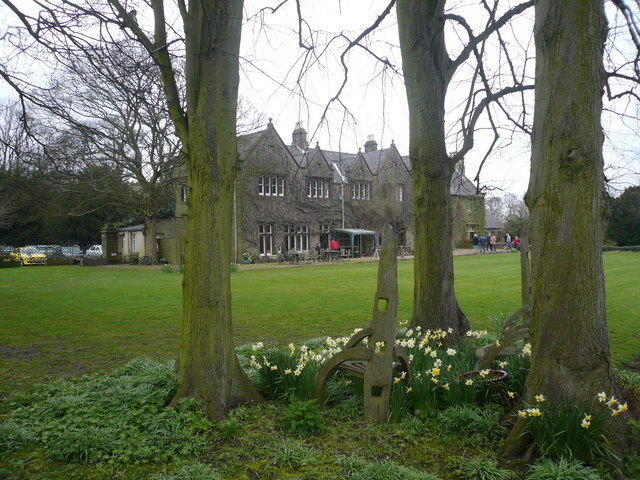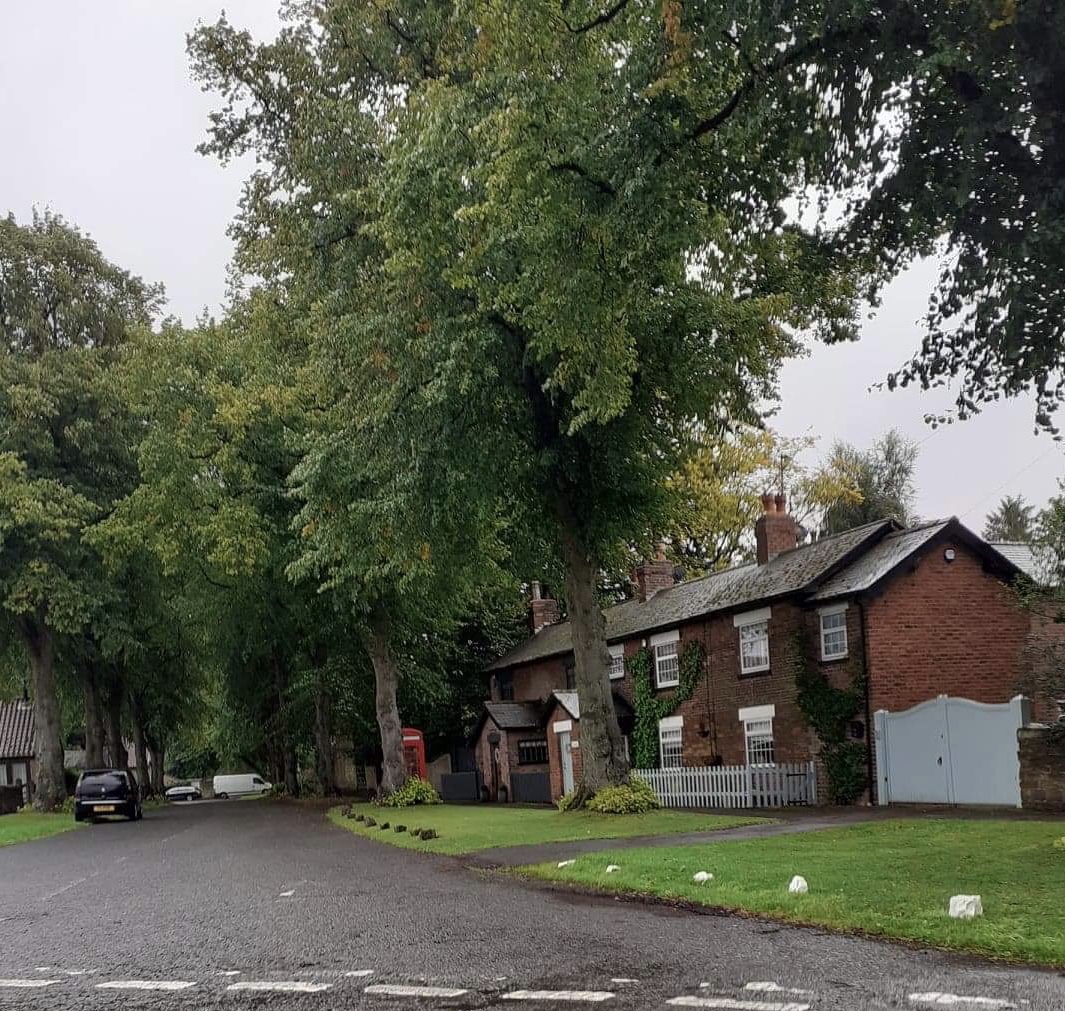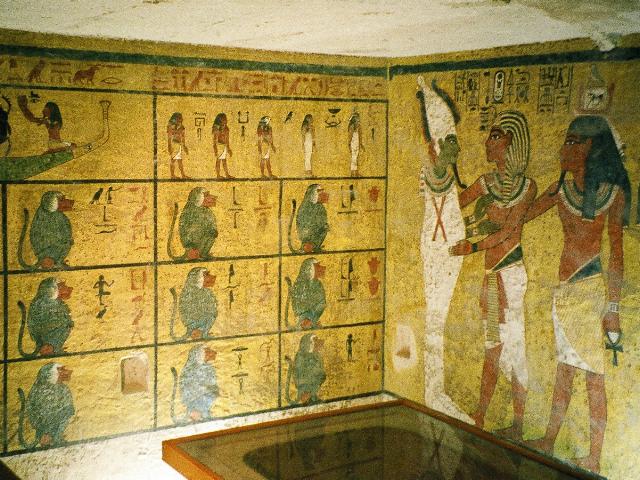|
Teversal Manor
Teversal Manor is a small Grade II listed 17th-century country house in Teversal, Nottinghamshire, some 5 km (3 miles) west of Mansfield. The building is constructed of coursed and dressed rubble stone with ashlar dressings and slate roofs. It is built in two storeys with attics with an irregular 7 bay frontage. History Prior to 1562 Roger Greenhalgh owned Teversal Manor. The manor was inherited in that year by Greenhalgh's son-in-law Francis Molyneux. He was High Sheriff of Nottinghamshire for 1582–83. His grandson Sir John Molyneux, 1st Baronet, was High Sheriff for 1609 and created a baronet in 1611. The Molyneux baronets and families remained in the village for about 150 years. The estate descended to Sir Francis Molyneux, 7th Baronet (1738-1812), who was a courtier who became Gentleman Usher of the Black Rod. On his death, unmarried, his estates at Teversal and Wellow passed to his nephew Henry Howard, who adopted the surname Molyneux-Howard and died in 1824. Tever ... [...More Info...] [...Related Items...] OR: [Wikipedia] [Google] [Baidu] |
Teversal Manor Garden - Geograph
Teversal is a small village in the Ashfield district of Nottinghamshire, England, west of Mansfield, close to Sutton-in-Ashfield and the boundary with Derbyshire. Former names include ''Tevershalt'', ''Teversholt'', ''Tyversholtee'', ''Teversale'', ''Tevershall'' and ''Teversall''. History Teversal (called Tevershall) is the site of fictional Wragby Hall, the home of Lady Chatterley in the novel ''Lady Chatterley's Lover'' by D. H. Lawrence. As part of the history of Beauchief Abbey, Sheffield in 1190-1225 William Barry, Lord of Teversal was granted two tofts and crofts in Stanley, a hamlet within the Teversal area. The grant meant that there was sufficient area for a farm. The land now is now Stanley Grange Farm. In 1525 Thomas North owned the Grange, where he kept his sheep. In 1537 William Bolles owned the Grange, he was a receiver of the governments dissolved monasteries at the time. Bolles later owned Felley Priory after the priory was dissolved in 1536, as part of K ... [...More Info...] [...Related Items...] OR: [Wikipedia] [Google] [Baidu] |
Henry Herbert, 3rd Earl Of Carnarvon
Henry John George Herbert, 3rd Earl of Carnarvon, FRS (8 June 1800 – 10 December 1849), styled Lord Porchester from 1811 to 1833, was a British writer, traveller, nobleman, and politician. Background and education Herbert was born in London, the eldest son of Henry Herbert, 2nd Earl of Carnarvon and Elizabeth "Kitty" Acland, daughter of John Dyke Acland of Pixton Park in Somerset. He was educated at Eton College and Christ Church, Oxford. Public life In 1831, Porchester was elected to the House of Commons for Wootton Bassett as a Tory, a seat he held until the following year when the constituency was abolished by the Great Reform Act. In 1833 he succeeded his father in the earldom and entered the House of Lords. He was elected a Fellow of the Royal Society in 1841. It was during Carnarvon's lifetime that the family seat of Highclere Castle was redesigned and rebuilt by Sir Charles Barry into a Victorian mansion. Cricket Herbert played first-class cricket in 1822 when he w ... [...More Info...] [...Related Items...] OR: [Wikipedia] [Google] [Baidu] |
Lady Chatterley’s Lover
''Lady Chatterley's Lover'' is the last novel by English author D. H. Lawrence, which was first published privately in 1928, in Italy, and in 1929, in France. An unexpurgated edition was not published openly in the United Kingdom until 1960, when it was the subject of a watershed R v Penguin Books Ltd, obscenity trial against the publisher Penguin Books, which won the case and quickly sold three million copies. The book was also banned for obscenity in the United States, Canada, Australia, India and Japan. The book soon became notorious for its story of the physical (and emotional) relationship between a working-class man and an upper-class woman, its explicit descriptions of sex and its use of then-unprintable four-letter words. Background The story is said to have originated from certain events in Lawrence's own unhappy domestic life, and he took inspiration for the settings of the book from Nottinghamshire, where he grew up. According to some critics, the fling of Lady Ottoli ... [...More Info...] [...Related Items...] OR: [Wikipedia] [Google] [Baidu] |
Virginia Woolf
Adeline Virginia Woolf (; ; 25 January 1882 28 March 1941) was an English writer, considered one of the most important modernist 20th-century authors and a pioneer in the use of stream of consciousness as a narrative device. Woolf was born into an affluent household in South Kensington, London, the seventh child of Julia Prinsep Jackson and Leslie Stephen in a blended family of eight which included the modernist painter Vanessa Bell. She was home-schooled in English classics and Victorian literature from a young age. From 1897 to 1901, she attended the Ladies' Department of King's College London, where she studied classics and history and came into contact with early reformers of women's higher education and the women's rights movement. Encouraged by her father, Woolf began writing professionally in 1900. After her father's death in 1904, the Stephen family moved from Kensington to the more bohemian Bloomsbury, where, in conjunction with the brothers' intellectual friends, t ... [...More Info...] [...Related Items...] OR: [Wikipedia] [Google] [Baidu] |
Aubrey Herbert
Colonel The Honourable Aubrey Nigel Henry Molyneux Herbert (3 April 1880 – 26 September 1923), of Pixton Park in Somerset and of Teversal, in Nottinghamshire, was a British soldier, diplomat, traveller, and intelligence officer associated with Albanian independence. He was twice offered the throne of Albania. From 1911 until his death he was a Conservative Member of Parliament. His eldest half-brother was George Herbert, 5th Earl of Carnarvon (1866–1923), who discovered the tomb of Tutankhamun. Origins Aubrey Herbert was born at Highclere Castle in Hampshire, the second son of Henry Herbert, 4th Earl of Carnarvon, a wealthy landowner, British cabinet minister, and Lord Lieutenant of Ireland. His mother (his father's second wife and cousin) was Elizabeth Catherine Howard (1856–1929Per inscribed brass tablet in Brushford Church) ("Elsie"), a daughter of Henry Howard of Greystoke Castle, near Penrith, Cumberland, a son of Lord Henry Howard-Molyneux-Howard, younger broth ... [...More Info...] [...Related Items...] OR: [Wikipedia] [Google] [Baidu] |
Howard Carter
Howard Carter (9 May 18742 March 1939) was a British archaeologist and Egyptologist who discovered the intact tomb of the 18th Dynasty Pharaoh Tutankhamun in November 1922, the best-preserved pharaonic tomb ever found in the Valley of the Kings. Early life Howard Carter was born in Kensington on 9 May 1874, the youngest child (of eleven) of artist and illustrator Samuel John Carter and Martha Joyce Carter (). His father helped train and develop his artistic talents. Carter spent much of his childhood with relatives in the Norfolk market town of Swaffham, the birthplace of both his parents. Receiving only limited formal education at Swaffham, he showed talent as an artist. The nearby mansion of the Amherst family, Didlington Hall, contained a sizable collection of Egyptian antiques, which sparked Carter's interest in that subject. Lady Amherst was impressed by his artistic skills, and in 1891 she prompted the Egypt Exploration Fund (EEF) to send Carter to assist an Amherst ... [...More Info...] [...Related Items...] OR: [Wikipedia] [Google] [Baidu] |
Almina Herbert, Countess Of Carnarvon
Almina Herbert, Countess of Carnarvon (née Wombwell; 14 April 1876 – 28 May 1969), was the wife of George Herbert, 5th Earl of Carnarvon, and châtelaine of Highclere Castle in Hampshire. After her second marriage, she became Mrs Almina Dennistoun, although she called herself Almina Carnarvon. It was her wealth that funded the search for Tutankhamun's tomb in Egypt. Life She was born Almina Victoria Maria Alexandra Wombwell, in Mayfair, London, the nominal child of Marie "Mina" Wombwell (née Boyer), the French wife of Captain Frederick Charles Wombwell, a businessman and retired British Army officer. However, her biological father was the banker Alfred de Rothschild, of the Rothschild family, who provided her with considerable wealth.Winstone (2006) p. 341. This included a £500,000 trust on her marriage and, on Rothschild's death in 1918, £50,000 and his Mayfair house with its art collection, much of which she sold.Winstone (2006) p. 344. On 26 June 1895, aged 19, she ... [...More Info...] [...Related Items...] OR: [Wikipedia] [Google] [Baidu] |
George Herbert, 5th Earl Of Carnarvon
George Edward Stanhope Molyneux Herbert, 5th Earl of Carnarvon, (26 June 1866 – 5 April 1923), styled Lord Porchester until 1890, was an English peer and aristocrat best known as the financial backer of the search for and excavation of Tutankhamun's tomb in the Valley of the Kings. Background and education Styled Lord Porchester from birth, he was born at 66 Grosvenor Street, Mayfair, London, the only son of Henry Herbert, 4th Earl of Carnarvon, a distinguished Tory statesman, by his first wife Lady Evelyn Stanhope, daughter of Anne and George Stanhope, 6th Earl of Chesterfield. Aubrey Herbert was his half-brother. He was educated at Eton College and Trinity College, Cambridge. He inherited the Bretby Hall estate in Derbyshire from his maternal grandmother, Anne Elizabeth, Dowager Countess of Chesterfield in 1885, and succeeded his father in the earldom in 1890. He was High Steward of Newbury. Family Lord Carnarvon married Almina Victoria Maria Alexandra Wombwell, ... [...More Info...] [...Related Items...] OR: [Wikipedia] [Google] [Baidu] |
Henry Herbert, 4th Earl Of Carnarvon
Henry Howard Molyneux Herbert, 4th Earl of Carnarvon, (24 June 1831 – 29 June 1890), known as Lord Porchester from 1833 to 1849, was a British politician and a leading member of the Conservative Party. He was twice Secretary of State for the Colonies and also served as Lord Lieutenant of Ireland. Origins Born at Grosvenor Square, London, Carnarvon was the eldest son and heir of Henry Herbert, 3rd Earl of Carnarvon (d.1849), by his wife Henrietta Anna Howard, a daughter of Lord Henry Howard-Molyneux-Howard, younger brother of Bernard Howard, 12th Duke of Norfolk. The Hon. Auberon Herbert was his younger brother. Youth He was educated at Eton College. In 1849, aged 18, he succeeded his father in the earldom. He attended Christ Church, Oxford, where his nickname was " Twitters", apparently on account of his nervous tics and twitchy behaviour, and where in 1852 he obtained a first in '' literae humaniores''. Early political career, 1854–66 Carnavon made his maiden speech i ... [...More Info...] [...Related Items...] OR: [Wikipedia] [Google] [Baidu] |
Lord Henry Howard-Molyneux-Howard
Lord Henry Thomas Howard-Molyneux-Howard (7 October 1766 – 17 June 1824), known as Henry Howard until 1812, and as Henry Molyneux-Howard until 1817, was a British gentleman who served as Deputy Earl Marshal in the latter part of the reign of George III and early in the reign of George IV. On the inheritance of the Dukedom of Norfolk in 1815 by his elder brother Bernard, Henry Molyneux-Howard in 1817 was granted the courtesy title "Lord", the style of a younger son of a duke. Origins Howard was the son of Henry Howard (1713–1787) by his wife Juliana Molyneux, daughter of Sir William Molyneux, 6th Baronet (died 1781), of Teversall, Nottinghamshire, High Sheriff of Nottinghamshire 1737. His father, Henry Howard, was a descendant of Bernard Howard (1641–1714), a younger son of Henry Howard, 22nd Earl of Arundel (1608–1652) and younger brother of Thomas Howard, 5th Duke of Norfolk (1627–1677) and Henry Howard, 6th Duke of Norfolk (1628-1684). Career On 24 May 1790 ... [...More Info...] [...Related Items...] OR: [Wikipedia] [Google] [Baidu] |
Teversal Manor And Manor Rooms Garden
Teversal is a small village in the Ashfield district of Nottinghamshire, England, west of Mansfield, close to Sutton-in-Ashfield and the boundary with Derbyshire. Former names include ''Tevershalt'', ''Teversholt'', ''Tyversholtee'', ''Teversale'', ''Tevershall'' and ''Teversall''. History Teversal (called Tevershall) is the site of fictional Wragby Hall, the home of Lady Chatterley in the novel '' Lady Chatterley's Lover'' by D. H. Lawrence. As part of the history of Beauchief Abbey, Sheffield in 1190-1225 William Barry, Lord of Teversal was granted two tofts and crofts in Stanley, a hamlet within the Teversal area. The grant meant that there was sufficient area for a farm. The land now is now Stanley Grange Farm. In 1525 Thomas North owned the Grange, where he kept his sheep. In 1537 William Bolles owned the Grange, he was a receiver of the governments dissolved monasteries at the time. Bolles later owned Felley Priory after the priory was dissolved in 1536, as part ... [...More Info...] [...Related Items...] OR: [Wikipedia] [Google] [Baidu] |
Gentleman Usher Of The Black Rod
Black Rod (officially known as the Lady Usher of the Black Rod or, if male, the Gentleman Usher of the Black Rod) is an official in the parliaments of several Commonwealth countries. The position originates in the House of Lords of the Parliament of the United Kingdom. The position is similar to one known as a serjeant-at-arms in other bodies. In the United Kingdom, Black Rod is principally responsible for controlling access to and maintaining order within the House of Lords and its precincts, as well as for ceremonial events within those precincts. Since early 2018, the post has been held for the first time by a woman, Sarah Clarke. Origin The office was created in 1350 by royal letters patent, though the current title dates from 1522. The position was adopted by other members of the Commonwealth when they adopted the British Westminster system. The title is derived from the staff of office, an ebony staff topped with a golden lion, which is the main symbol of the office's a ... [...More Info...] [...Related Items...] OR: [Wikipedia] [Google] [Baidu] |








